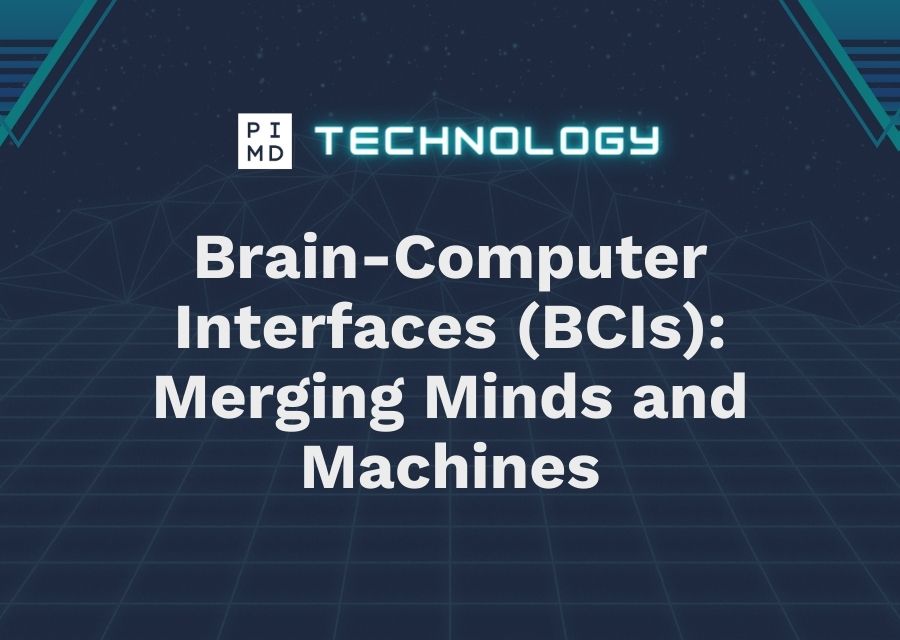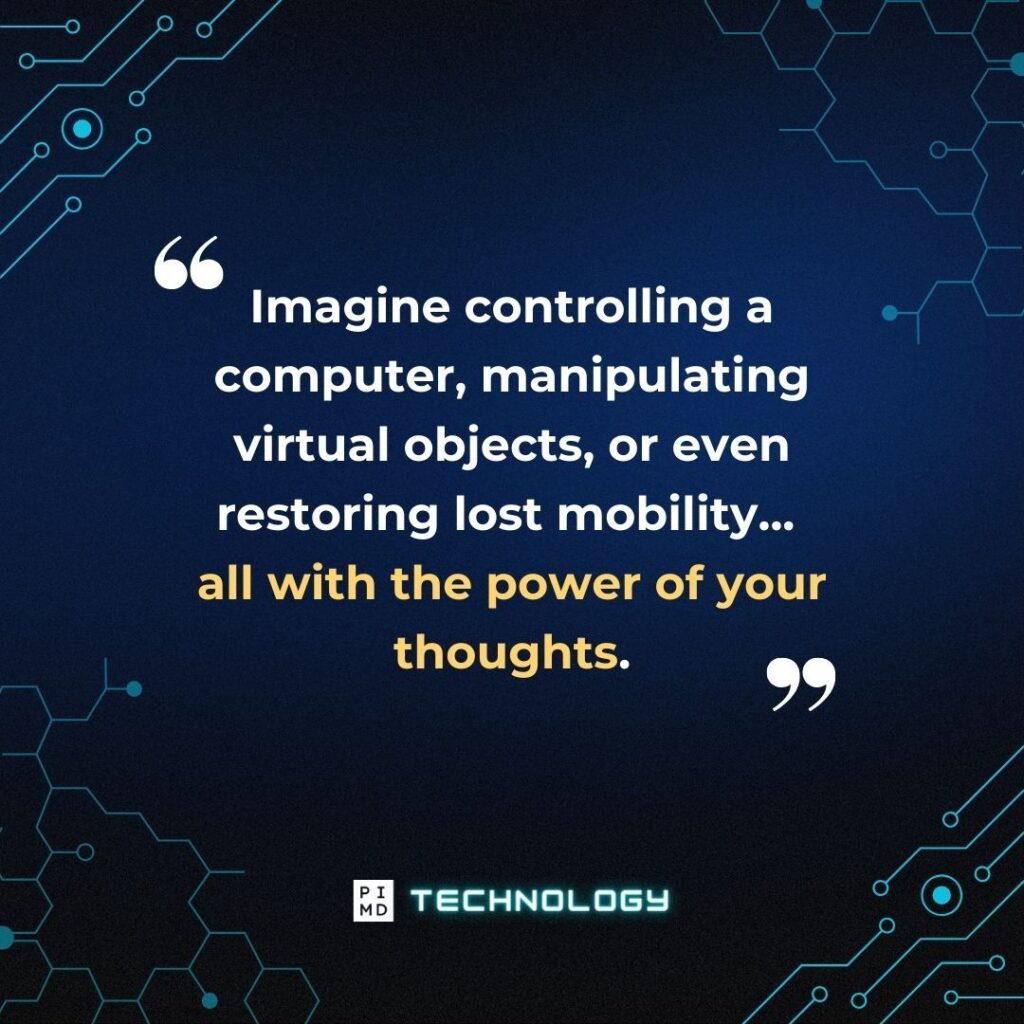
Brain-Computer Interfaces (BCIs): Merging Minds and Machines
This post may contain links from our sponsors. We provide you with accurate, reliable information. Learn more about how we make money and select our advertising partners.
Are you a fan of sci-fi movies like Robocop and Blade Runner? Well…
Imagine controlling a computer, manipulating virtual objects, or even restoring lost mobility… all with the power of your thoughts. This is the groundbreaking promise of Brain-Computer Interfaces (BCIs), a revolutionary technology bridging the gap between humans and machines.
But before you line up for that chip, let’s talk about why this may or may not be a good idea.
Table of Contents
By deciphering the electrical signals produced by our brains, BCIs offer a direct communication channel, opening doors to enhanced human capabilities, seamless interaction with technology, and life-changing possibilities for individuals with disabilities.
However, with such immense potential comes the responsibility to navigate ethical considerations and address potential challenges.
Privacy, security, and responsible development are crucial to ensuring that BCIs serve as a force for good, empower humanity, and shape a future where our minds truly become our ultimate tools.
What are BCIs and How Do They Work?
Stuck in a daydream imagining you’re the next Terminator? We get it. But before we jump the gun and start worrying about Skynet or the Matrix, how do these devices work their magic?
Different Paths to Brain Activity
BCIs come in three forms: invasive, non-invasive, and partially invasive.For high precision, invasive BCIs implant electrodes directly into the brain, though this approach requires surgery. Non-invasive BCIs, like wearable headsets, use external sensors to pick up brainwaves, making them safer and more readily available.
Partially invasive techniques find a middle ground, placing electrodes on the brain's surface.
Decoding the Language of Your Mind
The secret sauce of BCIs lies in three key steps: signal acquisition, processing, and output. First, brain activity is captured, often through EEG (scalp electrodes), ECoG (surface implants), or microelectrode arrays (deep brain implants).
These signals are then processed by sophisticated algorithms trained to recognize patterns and intentions hidden within the brainwaves. Finally, the decoded information is translated into actionable outputs, like moving a robotic arm or controlling a computer cursor.
Putting it into Practice: A Non-Invasive Example
Imagine wearing a BCI headset with electrodes on your scalp. As you focus on the thought of “move right,” the BCI detects specific brainwave patterns associated with that intention. The processed signal then controls a cursor on a screen, faithfully mirroring your mental command.
This example showcases how non-invasive BCIs can translate thought into action, opening doors to a world of possibilities for communication, rehabilitation, and even entertainment like enhanced virtual reality, or VR!

Interested in AI tools for personal or business use? SUBSCRIBE AND TUNE IN TO OUR PODCAST:
#169 Physician’s Tools of the Future: Harnessing the Power of AI, ft. Dr. Peter Kim
Unlocking Human Potential: Applications of BCIs
Brain-Computer Interfaces (BCIs) aren't just science fiction anymore. They're revolutionizing how we access and unleash our own capabilities, opening doors in medicine, cognitive enhancement, and even futuristic realms.
Let's dive into how BCIs are unlocking human potential across diverse frontiers:
Restoring Independence and Communication
For individuals with paralysis or speech loss, BCIs are more than just gadgets; they're lifelines. By decoding brain signals into actionable commands, BCIs can control robotic limbs, wheelchairs, and even virtual keyboards, restoring mobility and communication.
Imagine the impact on someone regaining the ability to hug a loved one or express themselves freely. This is the transformative power of BCIs in the medical field.
Boosting Brainpower and Creativity
BCIs aren't just for physical limitations. They can also enhance our cognitive abilities.
Think neurofeedback training improving focus and memory or brain stimulation unlocking untapped creative potential. These advances can help students, professionals, and even artists reach new heights in their pursuits.
Seamlessly Merging with Technology
Forget clunky keyboards and mouse clicks. BCIs promise a future where we interact with technology directly through thought. Imagine composing music, designing 3D models, or even navigating virtual worlds, all with the power of your mind.
BCIs could streamline workflows, boost productivity, and unleash new avenues for creative expression.
The Frontiers Await: Teleoperation and Beyond
The possibilities extend beyond traditional applications. Imagine controlling robots in hazardous environments or exploring distant planets using BCIs. Teleoperation, controlled by thought alone, opens doors to groundbreaking advancements in fields like space exploration, disaster response, and even surgery.
A Future Shaped by Thought
BCIs are not just technological marvels; they represent a paradigm shift in how we view human potential. They offer the chance to overcome limitations, enhance our capabilities, and redefine our relationship with technology. As this field evolves, the possibilities are limitless.
The future, shaped by thought, is closer than we ever imagined.

Don't miss the Leverage & Growth Summit this winter, a unique event tailored for physicians exploring entrepreneurial and growth opportunities beyond traditional clinical roles. It's an enriching platform offering inspiring keynotes from successful physician entrepreneurs, interactive workshops on various fields like digital health and investment, invaluable networking with like-minded professionals, and insightful panel discussions on healthcare trends.
This summit isn't just a conference; it's a movement towards expanding your professional horizons, empowering your entrepreneurial spirit, and connecting with pioneers reshaping healthcare. Mark your calendars for a transformative experience that promises to redefine the intersection of medicine and entrepreneurship.
Conclusion: The Future of BCIs – Challenges and Opportunities
Brain-computer interfaces are poised to revolutionize our world, not just by augmenting human capabilities but by fundamentally reshaping our relationship with technology.
Yet, this immense potential comes hand-in-hand with challenges that demand our attention.
*PS: Do you know that we offer FREE AI tools? We have one that will generate the best prompts. and a ChatGPT Cheat Sheet that will level up your AI experience. Get them now!
Balancing Progress with Ethics
As BCI technology races forward, ethical considerations cannot be left behind. Issues of privacy, informed consent, and equitable access must be addressed head-on.
Will our brain data be secure? Who controls its use? How do we ensure everyone has access to this life-changing technology?
Engaging in open and transparent dialogue with scientists, ethicists, policymakers, and the public is crucial to establishing responsible frameworks that guide BCI development and safeguard user well-being.
Conquering the Technical Frontier
The path to seamless BCI integration requires continuous research and development. Refining signal accuracy, overcoming bandwidth limitations, and ensuring long-term device safety are crucial hurdles to overcome.
Investing in research, promoting international collaboration, and fostering innovation are critical steps in propelling BCI technology towards its full potential.
Shaping the Future, Together
The story of BCIs is not one solely written by scientists and engineers. It is a narrative shaped by the choices we make as individuals and as a society.
By actively engaging in discussions, staying informed about advancements, and demanding responsible development, we can collectively ensure that BCIs serve as a force for good, empowering individuals, bridging divides, and ushering in a future where our minds truly become our ultimate tools.
That's it! If you’re wondering about other amazing digital tools, we have a collection of technological resources that you can explore, don’t miss out!
IF YOU WANT MORE CONTENT LIKE THIS, MAKE SURE YOU SUBSCRIBE TO OUR NEWSLETTER TO GET UPDATES ON THE LATEST TRENDS FOR AI, TECH, AND SO MUCH MORE.
Peter Kim, MD is the founder of Passive Income MD, the creator of Passive Real Estate Academy, and offers weekly education through his Monday podcast, the Passive Income MD Podcast. Join our community at the Passive Income Doc Facebook Group.
Frequently Asked Questions
Imagine controlling a computer or even a prosthetic limb with just your thoughts! That's the basic idea behind a BCI. It's a system that translates brain activity into actionable commands for external devices. By capturing electrical signals produced by our neurons, BCIs can decipher our intentions and translate them into real-world actions.
There are different types of BCIs, each with its own approach:
Non-invasive BCIs: These use electrodes placed on the scalp to pick up brainwaves. EEG (electroencephalogram) is a common non-invasive BCI that measues overall brain activity.
Invasive BCIs: These involve implanting electrodes directly into the brain, providing more precise control signals. However, they are more invasive and carry higher risks.
Partially invasive BCIs: These electrodes are implanted on the surface of the brain, offering a balance between precision and invasiveness.
Once the brain signals are captured, they are processed by algorithms that interpret their meaning. These algorithms are trained on data collected from individuals performing specific tasks, like imagining movement or focusing on particular stimuli.
Finally, the interpreted signals are used to control external devices, like a robotic arm or computer interface.
The possibilities are vast! Here are a few promising areas:
Medical rehabilitation: BCIs can help restore mobility and communication for individuals with paralysis, stroke, or other neurological conditions.
Cognitive enhancement: By providing real-time feedback on brain activity, BCIs could improve learning, memory, and attention.
Prosthetic control: BCIs can allow users to control artificial limbs with remarkable precision and naturalness.
Human-computer interaction: Imagine seamlessly interacting with your devices through thought alone, typing, controlling virtual environments, or even manipulating objects with your mind.
As with any powerful technology, BCIs raise ethical questions. Some key concerns include:
Privacy: How will our brain data be collected, stored, and used? Who will have access to it?
Agency and control: Will BCIs truly reflect our intentions, or could they be manipulated or hacked?
Accessibility and equity: Will BCIs be affordable and accessible to everyone or exacerbate existing inequalities?
Open and transparent discussions are crucial to ensure the responsible development and use of BCIs, prioritizing user privacy, safety, and well-being.
The field of BCI is rapidly evolving, with continuous advancements in technology and algorithms. The future holds exciting possibilities, like:
Brain-to-brain communication: Imagine directly sharing thoughts and experiences with others using BCIs.
Enhanced sensory perception: BCIs could potentially augment our senses, allowing us to see in infrared or hear ultrasonic frequencies.
Brain-computer integration: As BCIs become more sophisticated, the line between human and machine might blur, leading to a new era of human-machine symbiosis.
While challenges remain, the potential of BCIs to improve lives and redefine our relationship with technology is undeniable. As research progresses and ethical considerations are addressed, BCIs promise to open a new chapter in human evolution, one where thought becomes our ultimate tool.
Further Reading
Disclaimer: The topic presented in this article is provided as general information and for educational purposes. It is not a substitute for professional advice. Accordingly, before taking action, consult with your team of professionals.

